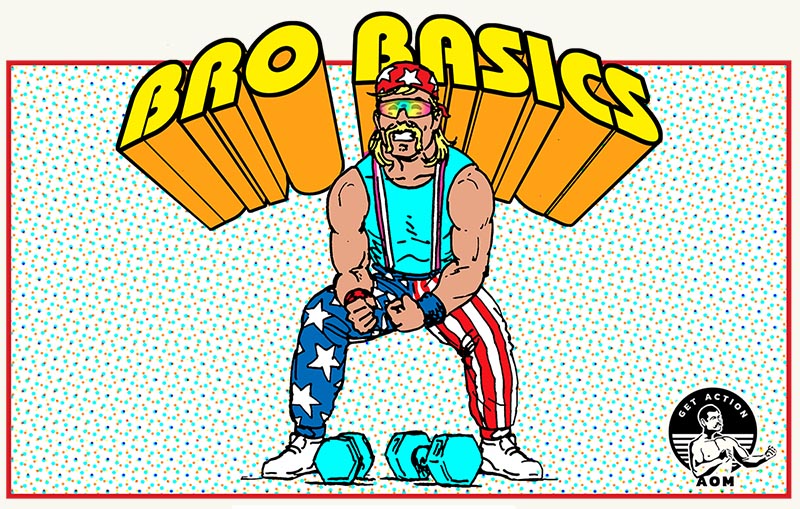
Welcome back to Bro Basics, a series which covers exercises that are popular and can be useful but are often done inadequately and solely for aesthetics, and shows the exercises’ broader function and how to perform them correctly.
In our first installment in this series, we covered how to do a classic bro exercise: the bicep curl. Today, we’re going to work the other side of your upper arm with another gym rat classic: the tricep extension. For insights on how best to perform this exercise, I talked with my strength coach and head of Barbell Logic Online Coaching, Matt Reynolds.
The Anatomy of the Tricep(s) Muscle
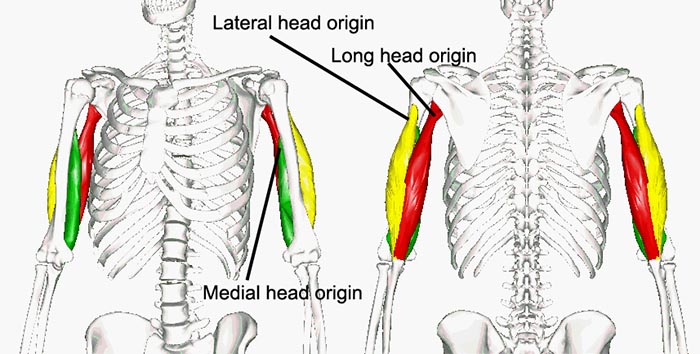
Before we look at how to perform different tricep extension variations, let’s do a quick anatomy lesson:
Like the biceps muscle, which we commonly refer to with the singular bicep, even though it’s technically the biceps muscle, plural, as it has two “heads” or parts, while we typically refer to the tricep of an arm, it’s technically the triceps muscle, as it consists of three heads: the lateral head, the medial head, and the long head. Each of these fascicles or bundles of muscle fibers has a specific functional role and can essentially be considered independent muscles. The three heads join together in a single tendon just above the elbow, and are what allow you to extend the elbow joint.
An important note about the triceps’ long head, which starts at the scapula and crosses the shoulder joint: to ensure that you work it and the entirety of the triceps muscle, you’ll want to perform tricep extensions in a way that uses the muscle’s full range of motion. This means that you’ll have a bit of shoulder movement during your tricep extensions and won’t merely be bending your elbow — more on this in a bit.
Why Do Tricep Extensions?
Strengthens a functional movement you do multiple times a day. The triceps muscle is what allows you to extend your arm at your elbow and straighten your arm. Think about all the daily movements you do that require elbow extension — throwing a punch, pushing a stalled car, climbing, shoveling, throwing, pressing heavy objects over your head. Tricep extensions can increase your force and capability in all of these movements by making your triceps stronger.
Contributes directly to the main barbell lifts. Whenever you bench press or shoulder press, your triceps play a significant role in your ability to successfully complete the lift. The triceps really come “online” at the lockout for the bench press and shoulder press. For many lifters, weak triceps cause plateaus in these two lifts. Tricep extensions are the best accessory exercise to strengthen this weak point.
Rehabs elbow tendonitis. If you’ve got pain in your elbow, tricep extensions can help bring more blood into the area, aiding in the healing of inflammation.
Makes your arms bigger. A lot of dudes do endless barbell curls, thinking that making their biceps bigger will make their arms bigger. But while curls can help increase your arm size, you actually get more bang for your beefing-up-the-gun-show buck by doing tricep extensions. “Remember, the triceps consist of three muscles, as opposed to the bicep, which is two. So the triceps make up most of your arm girth,” Matt told me. “For somebody who’s trying to get his arms as big as possible, tricep extensions will contribute even more to upper arm girth than bicep curls. Combine bicep curls and tricep extensions, and you can build gigantic upper arms.”
How to Do Tricep Extensions
Lying Tricep Extension
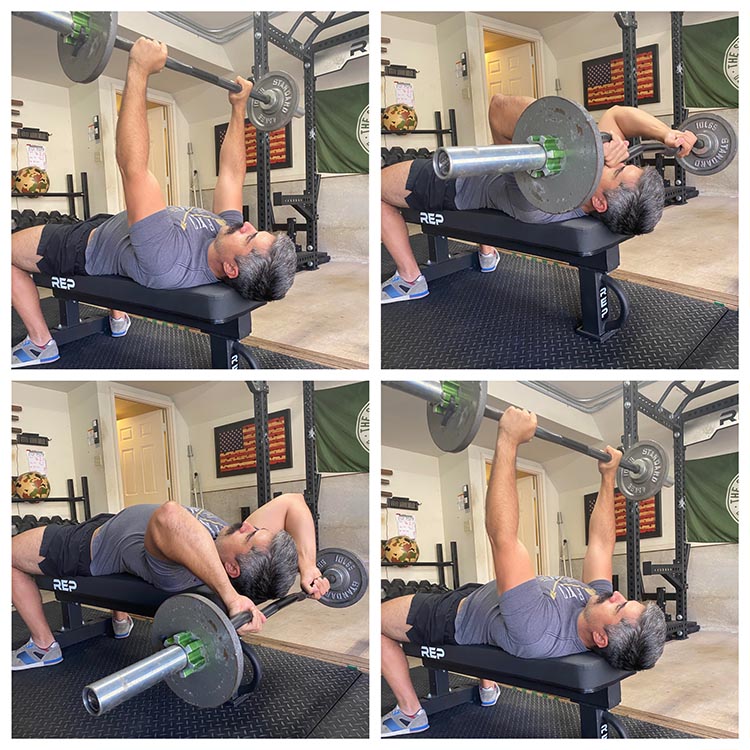
You’re going to need an EZ curl bar for this exercise. If you don’t have one, you can do the rolling dumbbell extension (see below) instead.
If you’ve done “skull crushers,” you’re familiar with the general movement involved with lying tricep extensions. Matt recommends one slight tweak to the standard skull crusher protocol, however, in order to work the full range of motion of the long head of the triceps.
- Lie on a bench with your head near the end. Hold the EZ bar above your face with a relatively close overhand grip on the second bent portion of the bar.
- Bend at your elbows and bring the bar down to the top of your head. On a skull crusher, you stop when the bar reaches your forehead and then extend your elbows and bring your hands back up. On the LTE, you’re going to let the bar pass closely over the top of your head, allowing the bar to go past your head and below your shoulders. You should feel a nice big stretch in the triceps. Letting the bar go this far allows you to work the full length of the triceps’ long head.
- Fire the barbell straight up and lock out over the shoulder joint.
Rolling Dumbbell Extension
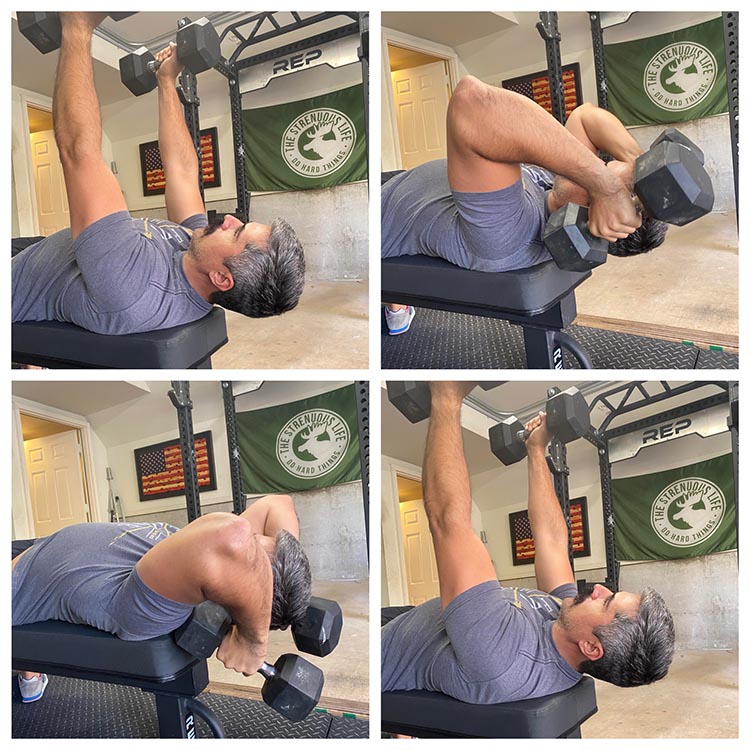
The rolling dumbbell extension is similar to the lying tricep extension, except you’re using dumbbells. “This is my favorite version of the tricep extension,” Matt told me. “You can get a bigger stretch in the back of your arms, which allows for more muscle activation during the exercise.”
- Grab two dumbbells and lie down on a bench so that your shoulders are even with the end of the bench. Hold the dumbbells in a neutral grip (palms facing each other) over the shoulder joint.
- Bend your elbows until the end of the dumbbells touch your shoulders.
- Roll the dumbbells back and get a nice big stretch in the back of your arms.
- Fire the dumbbells up and lock out over the shoulder joint.
Tricep Pushdowns
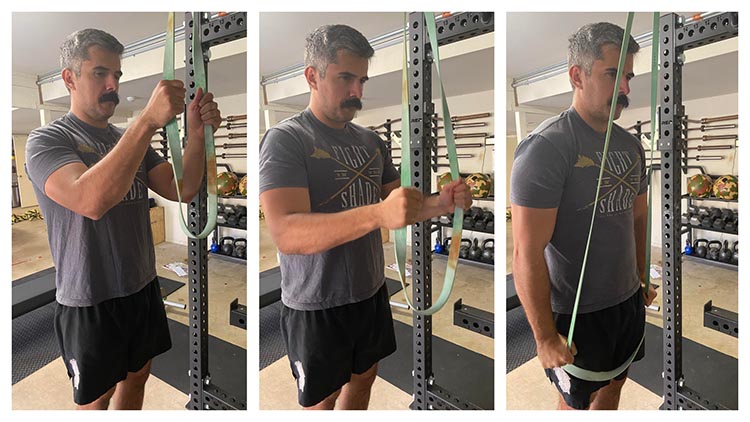
Matt also likes programming some version of the tricep pushdown, especially for prehab or rehab: “If I got a client who’s got some elbow pain, I’d program the tricep pushdown for a light weight at high reps. The goal is to flood the elbow joint area with blood to help the tendonitis heal.”
You typically do the tricep pushdown on a high cable machine using a straight bar or a tricep rope. If you don’t have access to a high cable machine, you can choke a resistance band around a pull-up bar.
- Stand straight with the chest up and shoulders back. Grab the rope/band in a neutral position. Elbows should be slightly in front of the body.
- Push the rope down until your arms are fully extended. Squeeze the triceps and get a nice full contraction.
- As you let your hands come back up, bend at the elbow first. When your elbows can’t bend anymore, lift your elbows up, bring your hands to about eye-level, and let the back of your arms get a nice stretch. Again, this allows you to work the triceps’ full range of motion.
Programming Tricep Extensions
As mentioned, the tricep extension is a great accessory exercise to the main barbell lifts. Matt typically programs my extensions on the days I do my upper-body workout.
“I like to superset tricep extensions with barbell curls,” Matt said. “That is, do your set of bicep curls and immediately after that, do your set of tricep extensions. Supersetting saves you time, and you’ll get an amazing ‘pump’ in your arms.”
For the lying tricep extensions and rolling tricep extensions, Matt recommends doing 3 sets of 10 at a decently heavy weight. Slowly add weight as you get stronger. This is how you’ll add that thick meat to the back of your arm while getting stronger.
As mentioned above, Matt likes to use tricep pushdowns for prehab/rehab. When doing the exercise for that purpose, he keeps the weight light and does sets of 20 reps.
Tags: Bro Basics, Exercises

